Detecting and Analyzing the Displacement of a Small-Magnitude Earthquake Cluster in Rong County, China by the GACOS Based InSAR Technology
Abstract
:1. Introduction
2. Study Area and Data
3. Methodology
4. Displacement Detection Based on GACOS InSAR
5. Discussion
6. Conclusions
Author Contributions
Funding
Data Availability Statement
Conflicts of Interest
References
- Yan, J.; Ye, Z.; Zheng, Y.; Shi, B. Investigation of Building Damage Characteristics and Human Casualties in Relation to the Ms4.7, Ms4.3, and Ms4.9 Earthquake Occurring in Rong County, Sichuan Province. China Earthq. Eng. J. 2020, 42, 1019–1023. [Google Scholar] [CrossRef]
- Moreira, A.; Prats-Iraola, P.; Younis, M.; Krieger, G.; Hajnsek, I.; Papathanassiou, K.P. A tutorial on synthetic aperture radar. IEEE Geosci. Remote Sens. Mag. 2013, 1, 6–43. [Google Scholar] [CrossRef] [Green Version]
- Moro, M.; Saroli, M.; Stramondo, S.; Bignami, C.; Albano, M.; Falcucci, E.; Gori, S.; Doglioni, C.; Polcari, M.; Tallini, M.; et al. New insights into earthquake precursors from InSAR. Sci. Rep. 2017, 7, 12035. [Google Scholar] [CrossRef] [PubMed] [Green Version]
- Béjar-Pizarro, M.; Álvarez Gómez, J.; Staller, A.; Luna, M.; Pérez-López, R.; Monserrat, O.; Chunga, K.; Lima, A.; Galve, J.; Martínez Díaz, J.; et al. InSAR-Based Mapping to Support Decision-Making after an Earthquake. Remote Sens. 2018, 10, 899. [Google Scholar] [CrossRef] [Green Version]
- Pritchard, M.E.; Biggs, J.; Wauthier, C.; Sansosti, E.; Arnold, D.W.D.; Delgado, F.; Ebmeier, S.K.; Henderson, S.T.; Stephens, K.; Cooper, C.; et al. Towards coordinated regional multi-satellite InSAR volcano observations: Results from the Latin America pilot project. J. Appl. Volcanol. 2018, 7, 5. [Google Scholar] [CrossRef]
- Garthwaite, M.C.; Miller, V.L.; Saunders, S.; Parks, M.M.; Hu, G.; Parker, A.L. A Simplified Approach to Operational InSAR Monitoring of Volcano Deformation in Low- and Middle-Income Countries: Case Study of Rabaul Caldera, Papua New Guinea. Front. Earth Sci. 2019, 6, 240. [Google Scholar] [CrossRef]
- Dai, K.; Li, Z.; Xu, Q.; Bürgmann, R.; Milledge, D.G.; Tomas, R.; Fan, X.; Zhao, C.; Liu, X.; Peng, J.; et al. Entering the era of Earth-Observation based landslide warning system. IEEE Geosci. Remote Sens. Mag. 2020, 8, 136–153. [Google Scholar] [CrossRef] [Green Version]
- Dai, K.; Li, Z.; Tomás, R.; Liu, G.; Yu, B.; Wang, X.; Cheng, H.; Chen, J.; Stockamp, J. Monitoring activity at the Daguangbao mega-landslide (China) using Sentinel-1 TOPS time series interferometry. Remote Sens. Environ. 2016, 186, 501–513. [Google Scholar] [CrossRef] [Green Version]
- Gao, M.; Gong, H.; Chen, B.; Li, X.; Zhou, C.; Shi, M.; Si, Y.; Chen, Z.; Duan, G. Regional Land Subsidence Analysis in Eastern Beijing Plain by InSAR Time Series and Wavelet Transforms. Remote Sens. 2018, 10, 365. [Google Scholar] [CrossRef] [Green Version]
- Zhang, Y.; Liu, Y.; Jin, M.; Jing, Y.; Liu, Y.; Liu, Y.; Sun, W.; Wei, J.; Chen, Y. Monitoring Land Subsidence in Wuhan City (China) using the SBAS-InSAR Method with Radarsat-2 Imagery Data. Sensors 2019, 19, 743. [Google Scholar] [CrossRef] [Green Version]
- Ganas, A.; Elias, P.; Briole, P.; Cannavo, F.; Valkaniotis, S.; Tsironi, V.; Partheniou, E.I. Ground Deformation and Seismic Fault Model of the M6.4 Durres (Albania) Nov. 26, 2019 Earthquake, Based on GNSS/INSAR Observations. Geosciences 2020, 10, 210. [Google Scholar] [CrossRef]
- Valkaniotis, S.; Briole, P.; Ganas, A.; Elias, P.; Kapetanidis, V.; Tsironi, V.; Fokaefs, A.; Partheniou, H.; Paschos, P. The Mw = 5.6 Kanallaki Earthquake of 21 March 2020 in West Epirus, Greece: Reverse Fault Model from InSAR Data and Seismotectonic Implications for Apulia-Eurasia Collision. Geosciences 2020, 10, 454. [Google Scholar] [CrossRef]
- Shen, Z.-K.; Sun, J.; Zhang, P.; Wan, Y.; Wang, M.; Bürgmann, R.; Zeng, Y.; Gan, W.; Liao, H.; Wang, Q. Slip maxima at fault junctions and rupturing of barriers during the 2008 Wenchuan earthquake. Nat. Geosci. 2009, 2, 718–724. [Google Scholar] [CrossRef]
- Qu, C.; Shan, X.; Zuo, R.; Zhang, G.; Liu, Y. An integrated study on the coseismic and post-seismic deformation of the 2010 Yushu earthquake based on InSAR analysis. J. Earth Syst. Sci. 2019, 128, 46. [Google Scholar] [CrossRef] [Green Version]
- Magen, Y.; Ziv, A.; Inbal, A.; Baer, G.; Hollingsworth, J. Fault Rerupture during the July 2019 Ridgecrest Earthquake Pair from Joint Slip Inversion of InSAR, Optical Imagery, and GPS. Bull. Seismol. Soc. Am. 2020, 110, 1627–1643. [Google Scholar] [CrossRef]
- Yang, C.; Han, B.; Zhao, C.; Du, J.; Zhang, D.; Zhu, S. Co- and post-seismic Deformation Mechanisms of the MW 7.3 Iran Earthquake (2017) Revealed by Sentinel-1 InSAR Observations. Remote Sens. 2019, 11, 418. [Google Scholar] [CrossRef] [Green Version]
- Albano, M.; Saroli, M.; Montuori, A.; Bignami, C.; Tolomei, C.; Polcari, M.; Pezzo, G.; Moro, M.; Atzori, S.; Stramondo, S.; et al. The Relationship between InSAR Coseismic Deformation and Earthquake-Induced Landslides Associated with the 2017 Mw 3.9 Ischia (Italy) Earthquake. Geosciences 2018, 8, 303. [Google Scholar] [CrossRef] [Green Version]
- Wang, S.; Zhang, Y.; Wang, Y.; Jiao, J.; Ji, Z.; Han, M. Post-seismic deformation mechanism of the July 2015 MW 6.5 Pishan earthquake revealed by Sentinel-1A InSAR observation. Sci. Rep. 2020, 10, 18536. [Google Scholar] [CrossRef]
- Vajedian, S.; Motagh, M.; Mousavi, Z.; Motaghi, K.; Fielding, E.; Akbari, B.; Wetzel, H.-U.; Darabi, A. Coseismic Deformation Field of the Mw 7.3 12 November 2017 Sarpol-e Zahab (Iran) Earthquake: A Decoupling Horizon in the Northern Zagros Mountains Inferred from InSAR Observations. Remote Sens. 2018, 10, 1589. [Google Scholar] [CrossRef] [Green Version]
- Wen, Y.; Xiao, Z.; He, P.; Zang, J.; Liu, Y.; Xu, C. Source Characteristics of the 2020 Mw 7.4 Oaxaca, Mexico, Earthquake Estimated from GPS, InSAR, and Teleseismic Waveforms. Seismol. Res. Lett. 2021, 92, 1900–1912. [Google Scholar] [CrossRef]
- Sichuan Geological Bureau. Regional Survey Report (Suining, Zigong, Neijiang, Yibin, Luzhou); Sichuan Geological Bureau: Chengdu, China, 1980. [Google Scholar]
- Fan, H.; Cheng, D.; Deng, K.; Chen, B.; Zhu, C. Subsidence monitoring using D-InSAR and probability integral prediction modelling in deep mining areas. Surv. Rev. 2015, 47, 438–445. [Google Scholar] [CrossRef]
- Suganthi, S.; Elango, L.; Subramanian, S.K. Microwave D-InSAR technique for assessment of land subsidence in Kolkata city, India. Arab. J. Geosci. 2017, 10, 458. [Google Scholar] [CrossRef]
- Wei, J.; Li, Z.; Hu, J.; Feng, G.; Duan, M. Anisotropy of atmospheric delay in InSAR and its effect on InSAR atmospheric correction. J. Geod. 2018, 93, 241–265. [Google Scholar] [CrossRef]
- Penney, C.; Tavakoli, F.; Saadat, A.; Nankali, H.R.; Sedighi, M.; Khorrami, F.; Sobouti, F.; Rafi, Z.; Copley, A.; Jackson, J.; et al. Megathrust and accretionary wedge properties and behaviour in the Makran subduction zone. Geophys. J. Int. 2017, 209, 1800–1830. [Google Scholar] [CrossRef]
- Zebker, H.A.; Rosen, P.A.; Hensley, S. Atmospheric effects in interferometric synthetic aperture radar surface deformation and topographic maps. J. Geophys. Res. Solid Earth 1997, 102, 7547–7563. [Google Scholar] [CrossRef]
- Xiao, R.; Yu, C.; Li, Z.; Song, C.; He, X. General Survey of Large-scale Land Subsidence by GACOS-Corrected InSAR Stacking: Case Study in North China Plain. Proc. Int. Assoc. Hydrol. Sci. 2020, 382, 213–218. [Google Scholar] [CrossRef] [Green Version]
- Xiao, R.; Yu, C.; Li, Z.; He, X. Statistical assessment metrics for InSAR atmospheric correction: Applications to generic atmospheric correction online service for InSAR (GACOS) in Eastern China. Int. J. Appl. Earth Obs. Geoinf. 2021, 96, 102289. [Google Scholar] [CrossRef]
- Yu, C.; Li, Z.; Chen, J.; Hu, J.-C. Small Magnitude Co-Seismic Deformation of the 2017 Mw 6.4 Nyingchi Earthquake Revealed by InSAR Measurements with Atmospheric Correction. Remote Sens. 2018, 10, 684. [Google Scholar] [CrossRef] [Green Version]
- Shen, L.; Hooper, A.; Elliott, J. A Spatially Varying Scaling Method for InSAR Tropospheric Corrections Using a High-Resolution Weather Model. J. Geophys. Res. Solid Earth 2019, 124, 4051–4068. [Google Scholar] [CrossRef] [Green Version]
- Yi, G.; Long, F.; Liang, M.; Zhao, M.; Wang, S. Geometry and tectonic deformation of seismogenic structures in the Rongxian-Weiyuan-Zizhong region, Sichuan Basin: Insights from focal mechanism solution. Chin. J. Geophys. 2020, 63, 3275–3291. [Google Scholar] [CrossRef]
- China Earthquake Network Center. Rongxian Earthquake. Available online: http://www.scdzj.gov.cn/xwzx/qqzx/20200-2/t2020021644270.html (accessed on 8 December 2020).

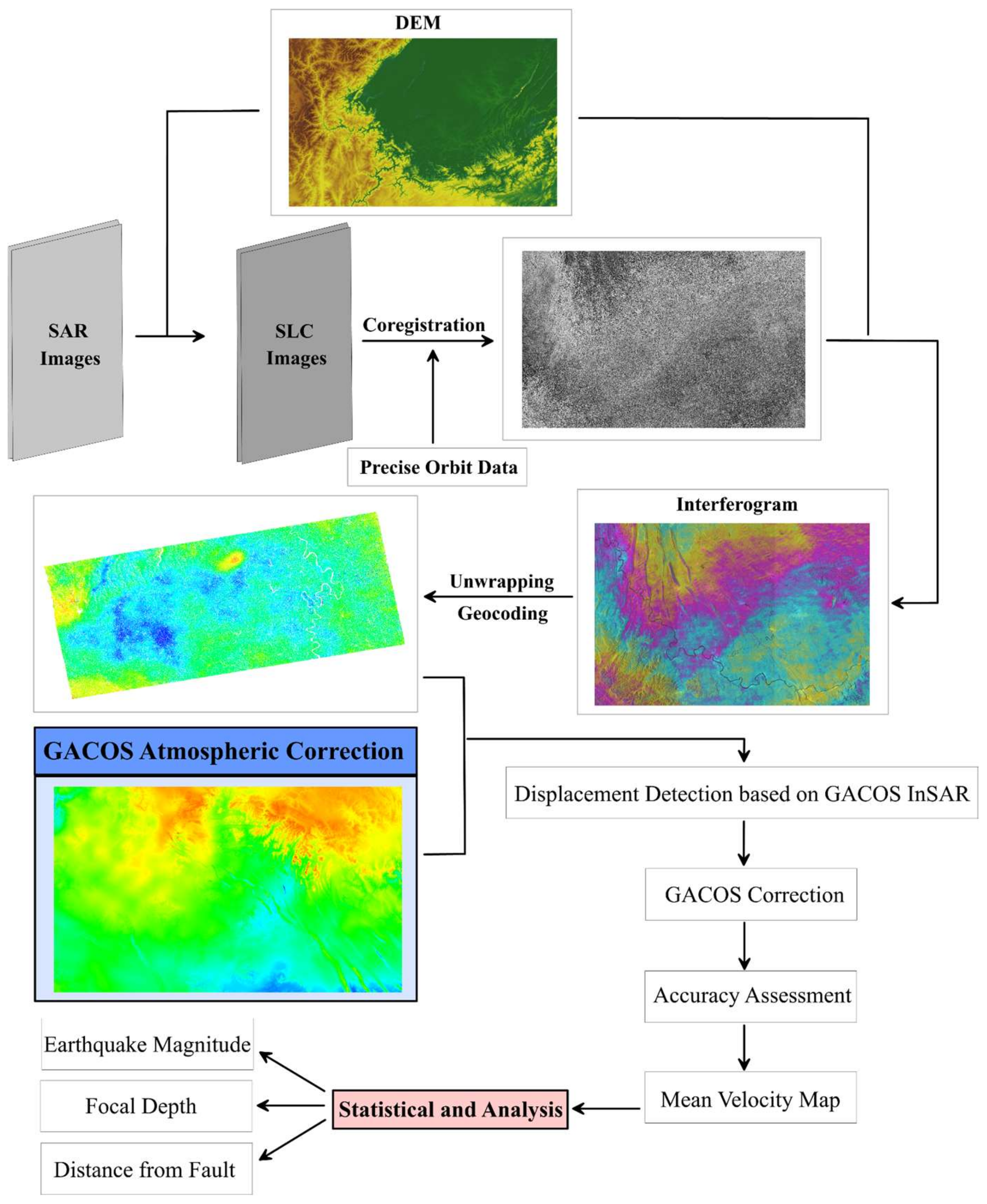
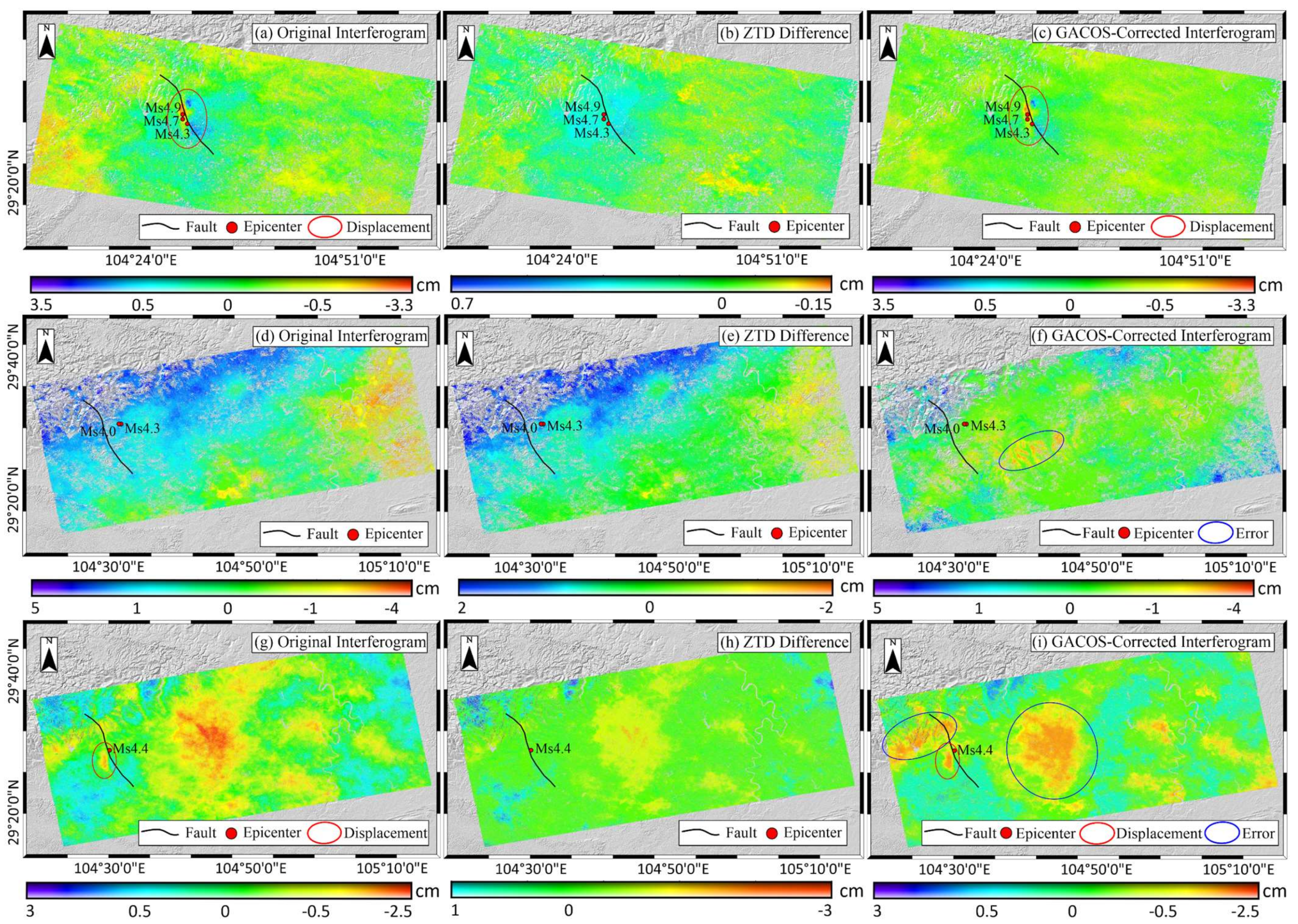
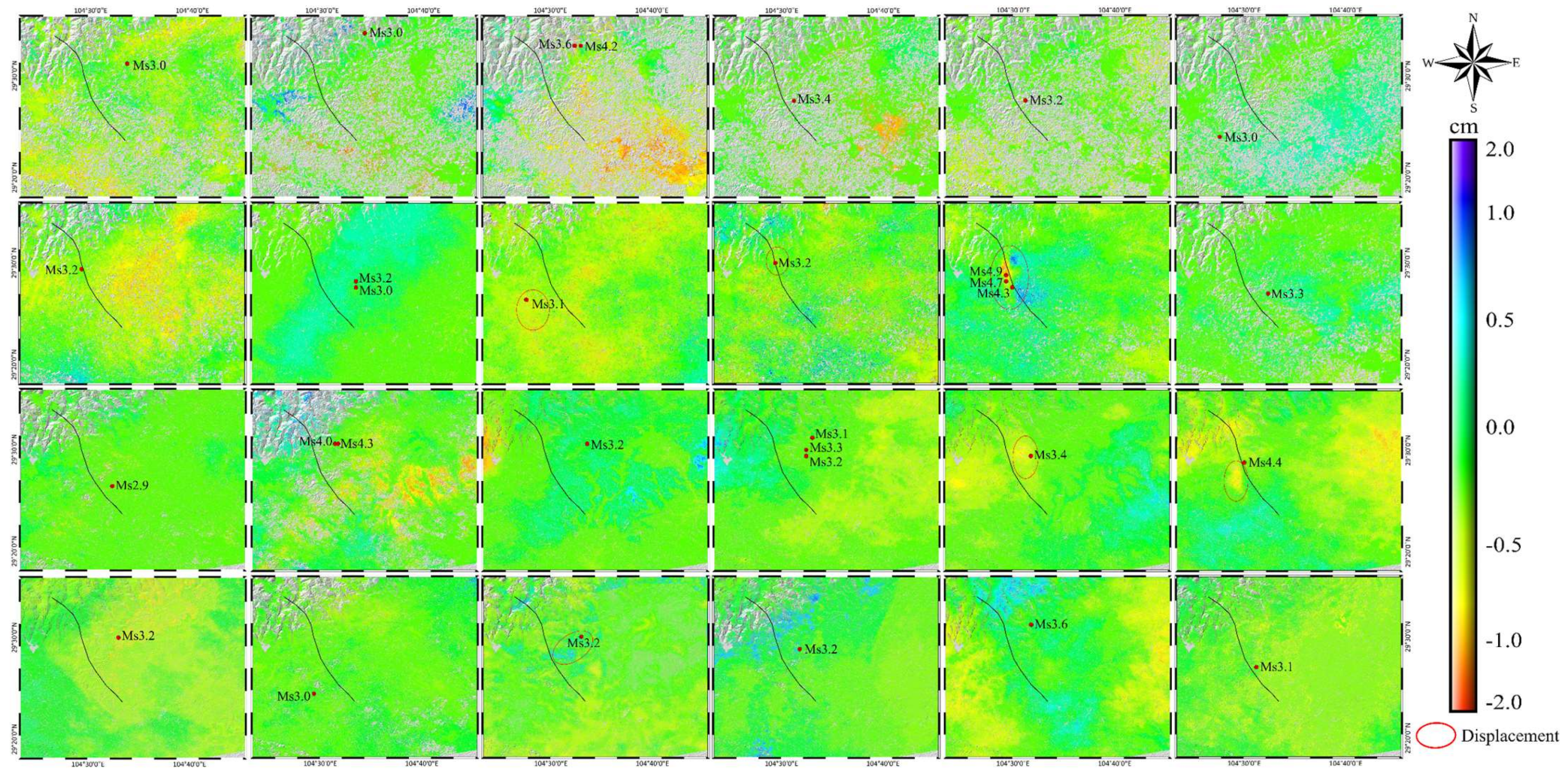
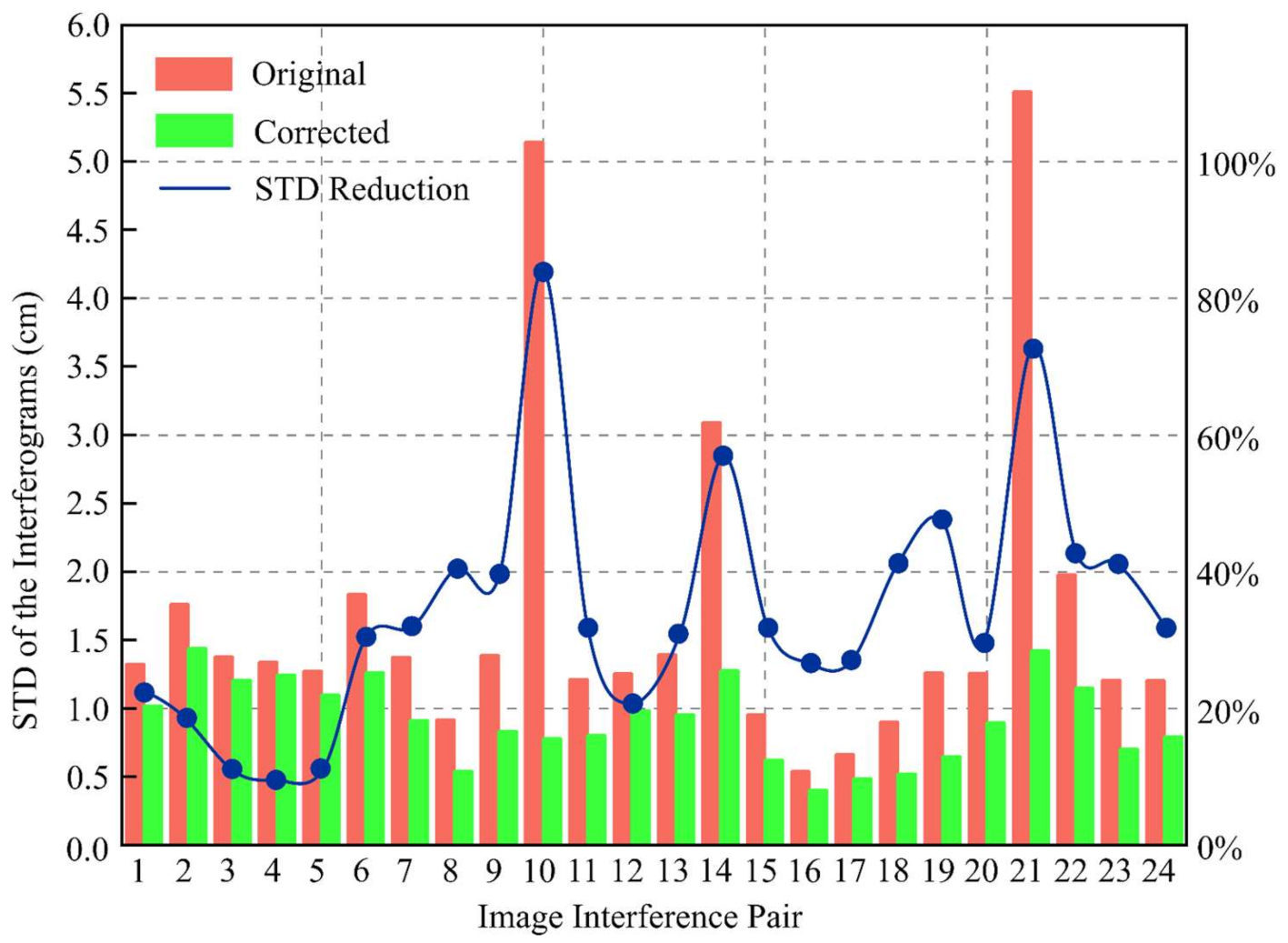

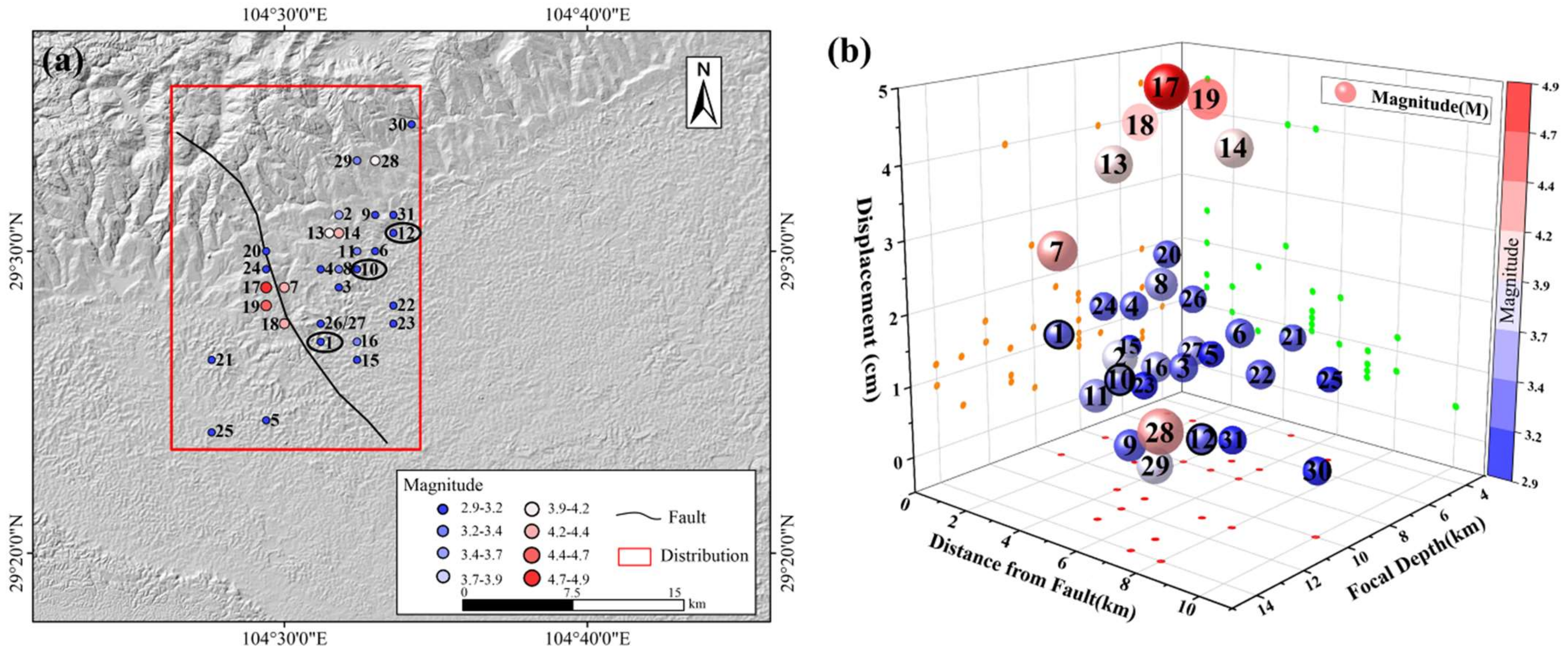
| Number | Magnitude (Mw) | Time | Latitude (°) | Longitude (°) | Depth (km) | Location |
|---|---|---|---|---|---|---|
| 1 | 3.1 | 2020-12-08 | 29.45 | 104.52 | 10 | Weiyuan County |
| 2 | 3.6 | 2020-10-28 | 29.52 | 104.53 | 12 | Weiyuan County |
| 3 | 3.2 | 2020-09-25 | 29.48 | 104.53 | 8 | Rong County |
| 4 | 3.2 | 2020-06-11 | 29.49 | 104.52 | 9 | Rong County |
| 5 | 3 | 2020-04-12 | 29.41 | 104.49 | 8 | Rong County |
| 6 | 3.2 | 2020-02-25 | 29.5 | 104.55 | 8 | Weiyuan County |
| 7 | 4.4 | 2020-02-16 | 29.48 | 104.5 | 10 | Rong County |
| 8 | 3.4 | 2020-01-01 | 29.49 | 104.53 | 9 | Rong County |
| 9 | 3.1 | 2019-12-30 | 29.52 | 104.55 | 14 | Weiyuan County |
| 10 | 3.2 | 2019-12-21 | 29.49 | 104.54 | 12 | Weiyuan County |
| 11 | 3.3 | 2019-12-20 | 29.5 | 104.54 | 13 | Weiyuan County |
| 12 | 3.2 | 2019-12-13 | 29.51 | 104.56 | 11 | Weiyuan County |
| 13 | 4 | 2019-09-10 | 29.51 | 104.49 | 11 | Rong County |
| 14 | 4.3 | 2019-09-08 | 29.51 | 104.53 | 7 | Weiyuan County |
| 15 | 2.9 | 2019-07-13 | 29.44 | 104.54 | 8 | Weiyuan County |
| 16 | 3.3 | 2019-03-08 | 29.45 | 104.53 | 8 | Weiyuan County |
| 17 | 4.9 | 2019-02-25 | 29.48 | 104.49 | 5 | Rong County |
| 18 | 4.3 | 2019-02-25 | 29.46 | 104.5 | 5 | Rong County |
| 19 | 4.7 | 2019-02-24 | 29.47 | 104.49 | 5 | Rong County |
| 20 | 3.2 | 2019-01-23 | 29.5 | 104.49 | 5 | Rong County |
| 21 | 3.1 | 2019-01-07 | 29.44 | 104.46 | 4 | Rong County |
| 22 | 3.2 | 2018-12-30 | 29.47 | 104.56 | 7 | Weiyuan County |
| 23 | 3 | 2018-12-29 | 29.46 | 104.56 | 11 | Weiyuan County |
| 24 | 3.2 | 2018-11-26 | 29.49 | 104.49 | 8 | Rong County |
| 25 | 3 | 2018-10-23 | 29.4 | 104.46 | 5 | Rong County |
| 26 | 3.2 | 2018-09-26 | 29.46 | 104.52 | 5 | Rong County |
| 27 | 3.4 | 2018-09-21 | 29.46 | 104.52 | 5 | Rong County |
| 28 | 4.2 | 2018-07-23 | 29.55 | 104.55 | 14 | Weiyuan County |
| 29 | 3.6 | 2018-07-23 | 29.55 | 104.54 | 13 | Weiyuan County |
| 30 | 3 | 2018-05-18 | 29.57 | 104.57 | 10 | Weiyuan County |
| 31 | 3 | 2018-03-30 | 29.52 | 104.56 | 11 | Weiyuan County |
| Parameter | Value |
|---|---|
| Temporal coverage | 2018.3–2020.12 |
| Orbital path number | 164/55 |
| Orbital direction | Ascending/Descending |
| Imaging mode | IW |
| Wavelength | 5.6 cm |
| Number of images | 45 |
| Azimuth pixel spacing | 13.99 m |
| Range pixel spacing | 2.33 m |
| Polarization | VV |
Publisher’s Note: MDPI stays neutral with regard to jurisdictional claims in published maps and institutional affiliations. |
© 2021 by the authors. Licensee MDPI, Basel, Switzerland. This article is an open access article distributed under the terms and conditions of the Creative Commons Attribution (CC BY) license (https://creativecommons.org/licenses/by/4.0/).
Share and Cite
Zhao, L.; Liang, R.; Shi, X.; Dai, K.; Cheng, J.; Cao, J. Detecting and Analyzing the Displacement of a Small-Magnitude Earthquake Cluster in Rong County, China by the GACOS Based InSAR Technology. Remote Sens. 2021, 13, 4137. https://doi.org/10.3390/rs13204137
Zhao L, Liang R, Shi X, Dai K, Cheng J, Cao J. Detecting and Analyzing the Displacement of a Small-Magnitude Earthquake Cluster in Rong County, China by the GACOS Based InSAR Technology. Remote Sensing. 2021; 13(20):4137. https://doi.org/10.3390/rs13204137
Chicago/Turabian StyleZhao, Liang, Rubing Liang, Xianlin Shi, Keren Dai, Jianhua Cheng, and Junxing Cao. 2021. "Detecting and Analyzing the Displacement of a Small-Magnitude Earthquake Cluster in Rong County, China by the GACOS Based InSAR Technology" Remote Sensing 13, no. 20: 4137. https://doi.org/10.3390/rs13204137
APA StyleZhao, L., Liang, R., Shi, X., Dai, K., Cheng, J., & Cao, J. (2021). Detecting and Analyzing the Displacement of a Small-Magnitude Earthquake Cluster in Rong County, China by the GACOS Based InSAR Technology. Remote Sensing, 13(20), 4137. https://doi.org/10.3390/rs13204137







